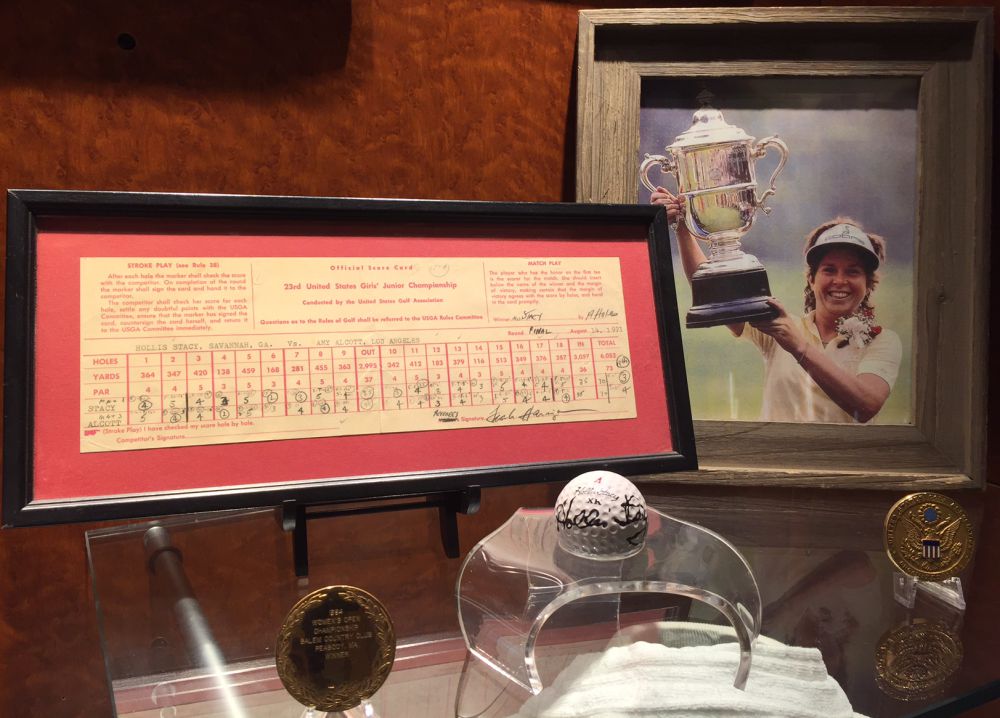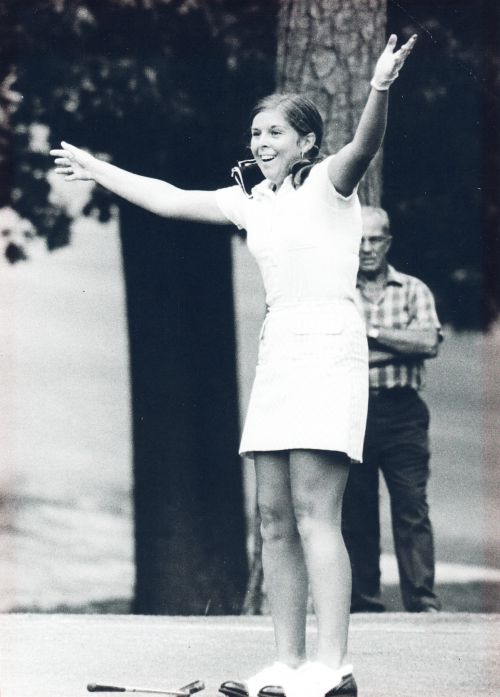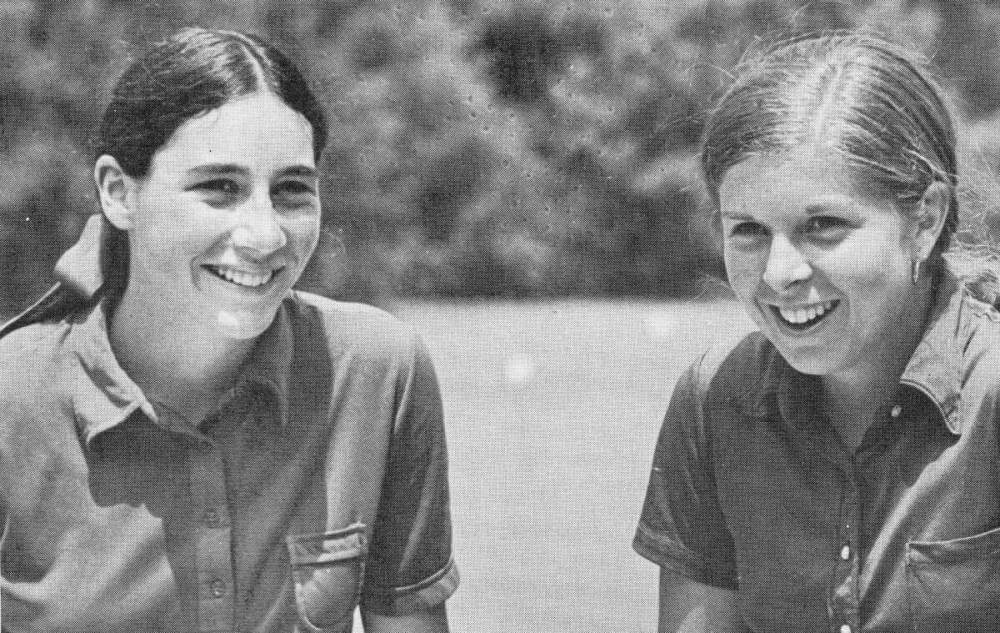Second in a series of Highlights from The World Golf Hall of Fame Museum by Curator, Travis Puterbaugh.
The U.S. Girls’ Junior Championship, held annually since 1949, has produced some of the greatest winners in the game’s history. World Golf Hall of Fame Members Mickey Wright, JoAnne Gunderson Carner, Hollis Stacy, Amy Alcott and Nancy Lopez can all claim the title, as can future Hall of Famer Inbee Park, as well as stars of today such as In-Kyung Kim, Lexi Thompson, Ariya Jutanugarn and Minjee Lee.
No one could have predicted, however, that a match between two juniors – a 15-year-old from California and a 17-year-old from Georgia – would rank not only as one of the greatest matches in the history of the tournament, but what former USGA Executive Director Frank Hannigan called “the most exciting match” he ever officiated: the 1971 final between Amy Alcott and Hollis Stacy.

Already a winner of the U.S. Girls’ Junior title in 1969, and the youngest person to win the event at 15, Stacy’s second consecutive win in 1970 cemented her status as a player on the rise. Standing in her way of a third straight title was an up-and-comer from Southern California by the name of Amy Alcott.
The stage for this showdown had been set two years prior at the U.S. Girls’ championship in Dallas at the Brookhaven Country Club. Stacy won the close opening round match against Alcott 3 and 2, but the brash 13-year-old Alcott made an impression on Stacy.
“I was down two after three or four holes, and I realized I had some stiff competition,” Stacy recalls. “Somehow I won and she got tired of me getting up and down from everywhere. I knew going into the ‘71 final that she was going to come at me fiercely and I had to be at the top of my game.”
Alcott remembers Stacy making the comment “where did you come from?” after taking the early lead. This was, Alcott says, the start of a “competitive friendship that would span into adulthood.”

While most players might succumb to the pressure of going for a third-straight championship, for Stacy it was more about playing well in front of friends and family who had made the short drive to the Augusta Country Club for the August 14, 1971, match. The pressure of playing near her hometown, Stacy says, overrode the pressure of going for a third championship.
Just as in 1969, Alcott again gave Stacy all she could handle and more. The two produced a thrilling match that featured 10 birdies and only three bogeys, and on the par-73 course, both Alcott and Stacy shot 3-under through 18.
After exchanging bogeys on the 1st and 2nd holes, they both played par and birdie golf from the 3rd to 17th holes. The two stared each other down from the 11th to 17th holes, matching each other par for par, but it was the final bogey of the day – by Stacy on the par-5 18th – that allowed Alcott to finally even up the match.
In the playoff on the 1st hole, Stacy’s second shot 4-iron hit just 10 feet from the hole to set her up well for a birdie putt. Alcott’s second shot left her 25 feet shy of the hole, but once again in a pressure situation, Stacy came through with a clutch putt to seal the victory.
The women were only getting started and would both go on to have long and distinguished careers on the LPGA Tour. Alcott, the recipient of the 1975 LPGA Rookie of the Year award, would win 29 times on the Tour, including five Major Championships. This included a small measure of payback in 1980 when she defeated Stacy by nine strokes to win the U.S. Women’s Open.
Although Stacy turned pro in 1974, she would not win her first event until 1977, the year that she won the first of her three U.S. Women’s Open championships. Her career included four Major Championships among her 18 wins on Tour. The competitors who started off on the same road crossing paths as junior golfers would both end their respective journeys in the World Golf Hall of Fame, with Alcott earning induction in 1999 and Stacy in 2012.
“I knew that she would be in my life competitively for many years,” Stacy says. “Sure enough, it happened. We both experienced the trials and tribulations of women’s golf and as a result became very good friends.”
Alcott concurs that the special relationship between the two was forged as junior competitors and continues to this day.
“I think there are some relationships that are written in the stars,” she says. “Hollis and I met as kids and we went on to have extremely successful professional careers. I think I’ve always had her number, and she’s had mine. Ultimately, it’s about the experiences you have and the people you meet in the sport that make it so wonderful.”
 Travis Puterbaugh is the Curator of the World Golf Hall of Fame & Museum in St. Augustine, Florida. He graduated from Loyola University of New Orleans with a B.A. in Communications, the University of South Florida with an M.A. in History, and has worked in the museum industry for 14 years. Travis considers getting to walk inside the ropes during Day One of the 2016 International Crown as the highlight of his time working for the Hall of Fame. Follow Travis on Twitter at @WGHOFCurator.
Travis Puterbaugh is the Curator of the World Golf Hall of Fame & Museum in St. Augustine, Florida. He graduated from Loyola University of New Orleans with a B.A. in Communications, the University of South Florida with an M.A. in History, and has worked in the museum industry for 14 years. Travis considers getting to walk inside the ropes during Day One of the 2016 International Crown as the highlight of his time working for the Hall of Fame. Follow Travis on Twitter at @WGHOFCurator.

The World Golf Hall of Fame & Museum celebrates golf and preserves the legacies of those who have made it great. The Hall of Fame & Museum, located at World Golf Village in St. Augustine, Florida, serves as a steward of the game through engaging, interactive storytelling and exhibitions featuring artifacts, works of art, audio, video, and photography significant to the history of golf and its members.
The museum is open daily and year-round except for Thanksgiving and Christmas. Hours of operation are Monday through Saturday from 10 am – 6 pm and Sunday from 12 pm – 6 pm. For more information, visit worldgolfhalloffame.org or call (904) 940-4000.
Follow news from the World Golf Hall of Fame on Facebook, Twitter, and Instagram.









